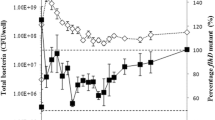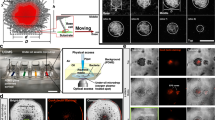Abstract
Eight Escherichia coli strains were studied in minimal medium with a continuous flow system using confocal microscopy. K12 wild-type strains ATCC 25404 and MG1655 formed the best biofilms (∼43 μm thick, 21 to 34% surface coverage). JM109, DH5α, and MG1655 motA formed intermediate biofilms (∼13 μm thick, 41 to 58% surface coverage). BW25113, MG1655 qseB, and MG1655 fliA had poor biofilms (surface coverage less than 5%). The best biofilm-formers, ATCC 25404 and MG1655, displayed the highest motility, whereas the worst biofilm former, BW25113, was motility-impaired. The differences in motility were due to differences in expression of the motility loci qseB, flhD, fliA, fliC, and motA (e.g., qseB expression in MG1655 was 139-fold higher than BW25113 and 209-fold higher than JM109). Motility affected the biofilm architecture as those strains which had poor motility (E. coli JM109, E. coli MG1655 motA, and DH5α) formed flatter microcolonies compared with MG1655 and ATCC 25404, which had more dramatic vertical structures as a result of their enhanced motility. The presence of flagella was also found to be important as qseB and fliA mutants (which lack flagella) had less biofilm than the isogenic paralyzed motA strain (threefold less thickness and 15-fold less surface coverage).



Similar content being viewed by others
References
Beloin C, Valle J, Latour-Lambert P, Faure P, Kzreminski M, Balestrino D, Haagensen JAJ, Molin S, Prensier G, Arbeille B, Ghigo J-M (2004) Global impact of mature biofilm lifestyle on Escherichia coli K-12 gene expression. Mol Microbiol 51:659–674
Blattner FR, Planrett G III, Bloch CA, Perna NT, Burland V, Riley M, Collado-Vides J, Glasner JD, Rode CK, Mayhew GF, Gregor J, Davis NW, Kirkpatrick HA, Goeden MA, Rose DJ, Mau B, Shao Y (1997) The complete genome sequence of Escherichia coli K-12. Science 277:1453–1462
Boles BR, Thoendel M, Singh PK (2004) Self-generated diversity produces “insurance effects” in biofilm communities. Proc Natl Acad Sci USA 101:16630–16635
Branda SS, Vik Å, Friedman L, Kolter R (2005) Biofilms: the matrix revisited. Trends Microbiol 13:20–26
Chang I, Gilbert ES, Eliashberg N, Keasling JD (2003) A three-dimensional stochastic simulation of biofilm growth and transport-related factors that affect structure. Microbiol 149:2859–2871
Chilcott GS, Hughes KT (2000) Coupling of flagellar gene expression to flagellar assembly in Salmonella entericaserovar typhimurium and Escherichia coli. Microbiol Mol Biol Rev 64:694–708
Datsenko KA, Wanner BL (2000) One-step inactivation of chromosomal genes in Escherichia coli K-12 using PCR products. Proc Natl Acad Sci USA 97:6640–6645
Davey ME, Caiazza NC, O’Toole GA (2003) Rhamnolipid surfactant production affects biofilm architecture in Pseudomonas aeruginosa PAO1. J Bacteriol 185:1027–1036
Elvers KT, Lappin-Scott HM (2000) Biofilms and biofouling, 2nd edn. Academic, San Diego, California
Espinosa-Urgel M (2003) Resident parking only: rhamnolipids maintain fluid channels in biofilms. J Bacteriol 185:699–700
Fishman A, Tao Y, L Rui, Wood TK (2005) Controlling the regiospecific oxidation of aromatics via active site engineering of toluene para-monooxygenase of Ralstonia pickettii PKO1. J Biol Chem 280:506–514
Ghigo J-M (2001) Natural conjugative plasmids induce bacterial biofilm development. Nature 412:442–445
Hansen MC, Palmer RJ Jr, Udsen C, White DC, Molin S (2001) Assessment of GFP fluorescence in cells of Streptococcus gordonii under conditions of low pH and low oxygen concentration. Microbiol 147:1383–1391
Heydorn A, Ersboll B, Kato J, Hentzer M, Parsek MR, Tolker-Nielsen T, Givskov M, Molin S (2002) Statistical analysis of Pseudomonas aeruginosa biofilm development: impact of mutations in genes involved in twitching motility, cell-to-cell signaling, and stationary-phase sigma factor expression. Appl Environ Microbiol 68:2008–2017
Heydorn A, Nielsen AT, Hentzer M, Sternberg C, Givskov M, Ersbøll BK, Molin S (2000) Quantification of biofilm structures by the novel computer program COMSTAT. Microbiol 146:2395–2407
Kang Y, Durfee T, Glasner JD, Qiu Y, Frisch D, Winterberg KM, Blatnner FR (2004) Systematic mutagenesis of the Escherichia coli genome. J Bacteriol 186:4921–4930
Lazazzera BA (2005) Lessons from DNA microarray analysis: the gene expression profile of biofilms. Curr Opin Microbiol 8:222–227
Lequette Y, Greenberg EP (2005) Timing and localization of rhamnolipid synthesis gene expression in Pseudomonas aeruginosa biofilms. J Bacteriol 187:37–44
Pham TH, Webb JS, Rehm BHA (2004) The role of polyhydroxyalkanoate biosynthesis by Pseudomonas aeruginosa in rhamnolipid and alginate production as well as stress tolerance and biofilm formation. Microbiol 150:3405–3413
Potera C (1999) Forging a link between biofilms and disease. Science 283:1837–1839
Pratt LA, Kolter R (1998) Genetic analysis of Escherichia coli biofilm formation: roles of flagella, motility, chemotaxis and type I pili. Mol Microbiol 30:285–293
Reisner A, Haagensen JAJ, Schembri MA, Zechner EL, Molin S (2003) Development and maturation of Escherichia coli K-12 biofilms. Mol Microbiol 48:933–946
Ren D, Bedzyk LA, Thomas SM, Ye RW, Wood TK (2004) Gene expression in Escherichia coli biofilms. Appl Microbiol Biotechnol 64:515–524
Ren D, Sims JJ, Wood TK (2001) Inhibition of biofilm formation and swarming of Escherichia coli by (5Z)-4-bromo-5-(bromomethylene)-3-butyl-2(5H)-furanone. Environ Microbiol 3:731–736
Rodriguez RL, Tait RC (1983) Recombinant DNA techniques: an introduction. Benjamin/Cummings Publishing, Menlo Park, CA
Sambrook J, Fritsch EF, Maniatis T (1989) Molecular cloning, a laboratory manual, 2nd ed. Cold Spring Harbor Laboratory, Cold Spring Harbor, NY
Schembri MA, Kjærgaard K, Klemm P (2003) Global gene expression in Escherichia coli biofilms. Mol Microbiol 48:253–267
Sperandio V, Torres AG, Kaper JB (2002) Quorum sensing Escherichia coli regulators B and C (QseBC): a novel two-component regulatory system involved in the regulation of flagella and motility by quorum sensing in E. coli. Mol Microbiol 43:809–821
Stanley NR, Britton RA, Grossman AD, Lazazzera BA (2003) Identification of catabolite repression as a physiological regulator of biofilm formation by Bacillus subtilis by use of DNA microarrays. J Bacteriol 185:1951–1957
Stoodley P, Lewandowski Z, Boyle JD, Lappin-Scott HM (1999) The formation of migratory ripples in a mixed species bacterial biofilm growing in turbulent flow. Environ Microbiol 1:447–455
Szomolay B, Klapper I, Dockerty J, Stewart PS (2005) Adaptative responses to antimicrobial agents in biofilms. Environ Microbiol 7:1186–1191
Walker SL, Redman JA, Elimelech M (2004) Role of cell surface lipopolysaccharides in Escherichia coli K12 adhesion and transport. Langmuir 20:7736–7746
Werner E, Roe F, Bugnicourt A, Franklin MJ, Heydorn A, Molin S, Pitts B, Stewart PS (2004) Stratified growth in Pseudomonas aeruginosa biofilms. Appl Environ Microbiol 70:6188–6196
Whiteley M, Bangera MG, Bumgarner RE, Parsek MR, Teitzel GM, Lory S, Greenberg EP (2001) Gene expression in Pseudomonas aeruginosa biofilms. Nature 413:860–864
Wood TK, Peretti SW (1991) Effect of chemically-induced, cloned-gene expression on protein synthesis in E. coli. Biotechnol Bioeng 38:397–412
Yanisch-Perron C, Vieira J, Messing J (1985) Improved M13 phage cloning vectors and host strains: nucleotide sequences of the M13mp18 and pUC19 vectors. Gene 33:103–119
Acknowledgements
We thank A. Heydorn from the Technical University of Denmark for kindly providing COMSTAT, S. Molin from the Technical University of Denmark for sending plasmid pCM18, and J. Kaper from the University of Maryland for sending plasmids pVS159, pVS176, pVS175, pVS182, and pVS183.
Author information
Authors and Affiliations
Corresponding author
Rights and permissions
About this article
Cite this article
Wood, T.K., González Barrios, A.F., Herzberg, M. et al. Motility influences biofilm architecture in Escherichia coli . Appl Microbiol Biotechnol 72, 361–367 (2006). https://doi.org/10.1007/s00253-005-0263-8
Received:
Revised:
Accepted:
Published:
Issue Date:
DOI: https://doi.org/10.1007/s00253-005-0263-8




